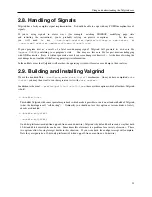
Using and understanding the Valgrind core
locations is regrettable, but is about all you can hope for, given that the X11 libraries shipped on the Linux distro on
which this example was made have had their symbol tables removed.
Although the above two examples do not make this clear, you can freely mix
obj:
and
fun:
lines in a suppression.
Finally, here’s an example using three frame-level wildcards:
{
a-contrived-example
Memcheck:Leak
fun:malloc
...
fun:ddd
...
fun:ccc
...
fun:main
}
This suppresses Memcheck memory-leak errors, in the case where the allocation was done by
main
calling (though
any number of intermediaries, including zero)
ccc
, calling onwards via
ddd
and eventually to
malloc.
.
2.6. Core Command-line Options
As mentioned above, Valgrind’s core accepts a common set of options. The tools also accept tool-specific options,
which are documented separately for each tool.
Valgrind’s default settings succeed in giving reasonable behaviour in most cases. We group the available options by
rough categories.
2.6.1. Tool-selection Option
The single most important option.
--tool=<toolname> [default:
memcheck]
Run the Valgrind tool called
toolname
, e.g. Memcheck, Cachegrind, etc.
2.6.2. Basic Options
These options work with all tools.
-h --help
Show help for all options, both for the core and for the selected tool. If the option is repeated it is equivalent to giving
--help-debug
.
--help-debug
Same as
--help
, but also lists debugging options which usually are only of use to Valgrind’s developers.
9
















































